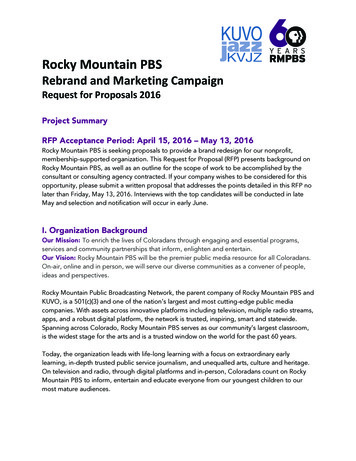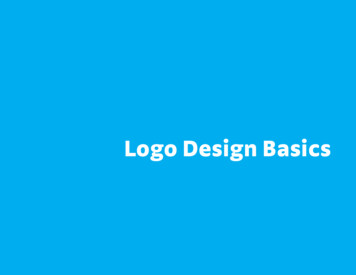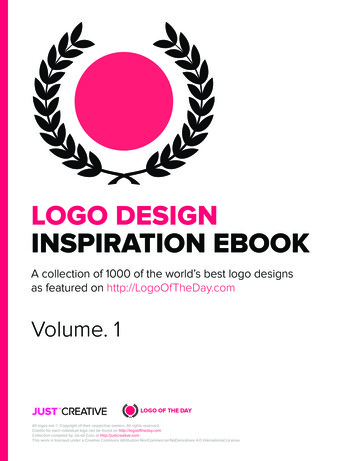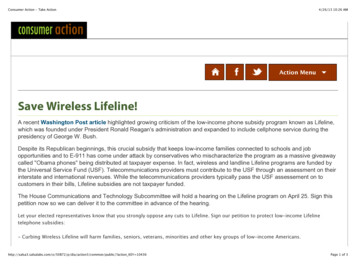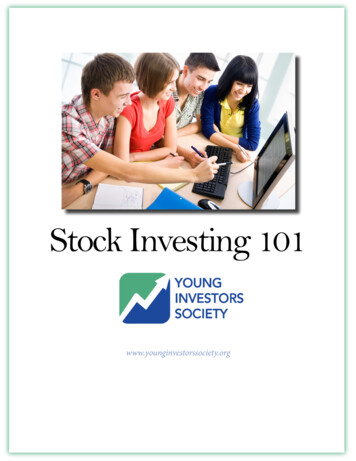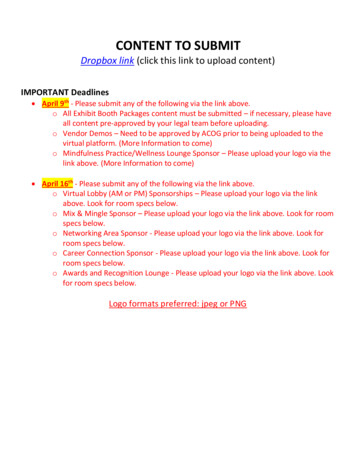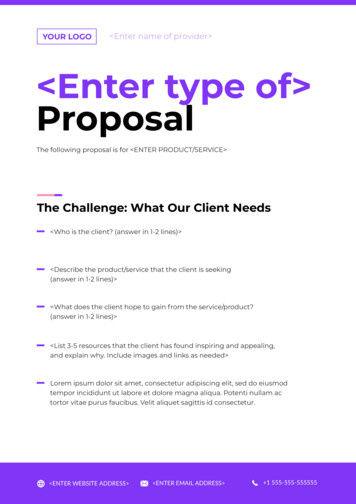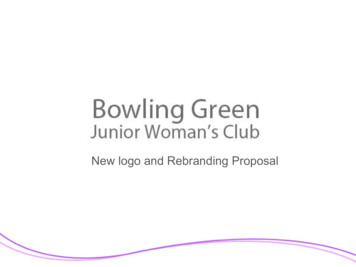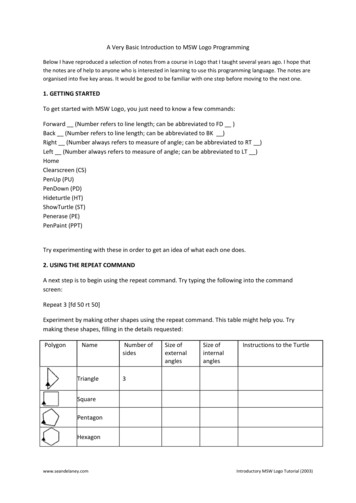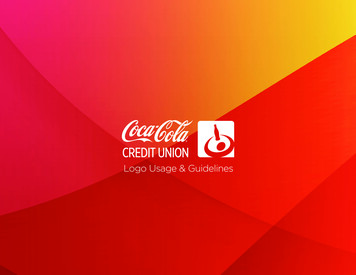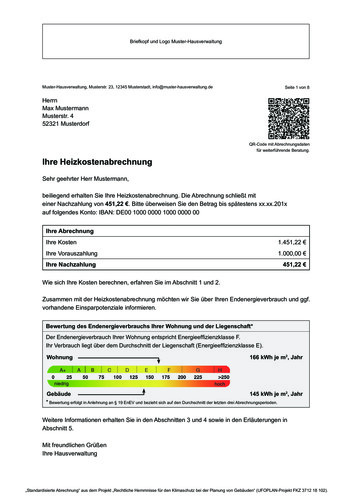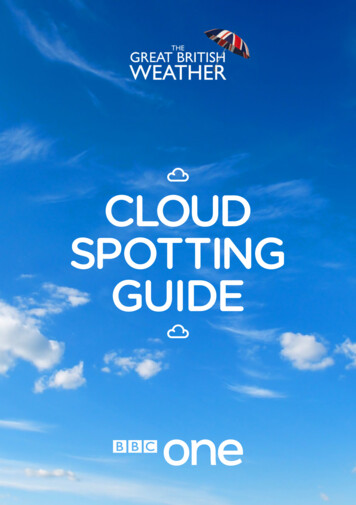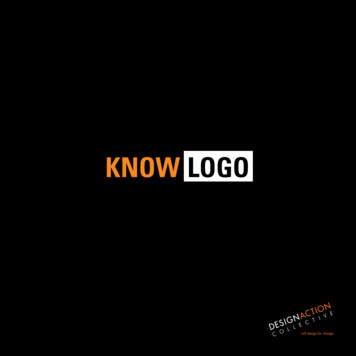
Transcription
KNOW LOGOi
Design Action Collective. 2011. 1st edition.All logos in this book were designed by Design Action Collective with the exception of thelogos for HRC, the Black Panthers, the United Farm Workers, and Greenpeace.
KNOW LOGOdesigning logos for social change
WHAT IS A LOGO?2
The term “logo” is often defined differently and used todescribe different things, even within the field of graphicdesign. Design Action works primarily with social changeorganizations (grassroots groups, nonprofits, unions andsustainable businesses) so we use the term to describe:A signature image and textcombination that identifiesan organization, campaign orproject.3
Logos are usually some combination of three elements:the symbol, the wordmark and the tagline.S Y M B OLWOR DMAR KTA G LINEspacing4spacing
Some may be made up of just the wordmark:Some logos may have the symbol and wordmark:GIFT Logo—4 color processOr some may integrate the symbol and wordmark:FONT: CLEARFACE GOTHICCOLORS: PMS 125 GOLDAND PMS 295 BLUE1CMYK48010053CMYK57980465
OTHER JARGON6
When you start talking logo, youwill soon start hearing a bunch ofother terms that sound cool andprofessional. Most are thrown aroundloosely by people trying to sound cooland professional, and may not reallyhelp you understand the process. Butwhen used properly, some of theseterms can be useful shorthand, sohere are a few common ones . . .7
Identity System:All the elements that your group uses in concert tocommunicate a cohesive and recognizable presence. Thissystem includes visual elements such as your logo, your colorpalette and other print and web communications pieces, aswell as writing style, tone, and key messaging elements.Example: IRN redid their identity with us in 2008. Their new identity systemincluded shortening the name to International Rivers (and ditching the acronym),a new logo and tagline, a new color palette, and a style guide describing logousage, color palette and fonts, and templates for their most common publications.Old Logo8New Logo
Brand:How the world perceives your organization, based on howit has been presented through the use of the logo, identity,press coverage, interactions, etc. We can design your logoand identity system, but how your constituency perceives you(your “brand”) will depend on that, and everything else you do.Example: Think Greenpeace*—their logo is just their name in a funky font. Buttheir brand is one of the strongest in the environmental activist world.Signature:Used synonymously with “logo.”Mark:Used to describe the “symbol” part of the logo. Also referredto as the “logo mark.”*Design Action did not design the Greenpeace logo9
Style Guide:A document describing such things as logo usage, colorpalette, fonts, images, etc., that have been approved foryour organization. This Guide will allow future designers andpeople producing materials in-house the know-how to makeyour materials look consistent. Helping everyone adhereto a consistent presentation of your “identity” is part of thestrategy for developing your “brand.” Depending on howextensive the Guide is, you will see this document titled “LogoUsage,” or “Organizational Identity,” or “Brand Guidelines.” Orsometimes you’ll see “Logo Identity Brand Guidelines.” As wesaid, there’s a lot of jargon in this business.10
11
Print Collateral:All communications and outreach materials that your logogoes on, like brochures, factsheets, stationery, etc.Business Suite:Specifically, letterhead, business cards and envelopes.12
13
why Do youneed a logo?14
This is a “What, Why, and How”guide to logo design. But as amovement-servicing organization, wehave to first suggest you ask “WhyNot.” With organizational resourcesbeing so thinly distributed, and truerevolutionary change coming throughaction, not just image, it is worthconsidering if spending time, moneyand energy on a logo process isappropriate for your organization.15
For some organizations the answer will be obviously, yes.But for others, particularly start-ups with limited funding,perhaps the logo is not the first thing that is needed.Perhaps building a strong reputation for successfulcampaigns or services is more important to your organizationthan the logo. Perhaps something simple and clean (or evenhomemade!) is what will give you “street-cred.” Perhaps aniconic image will emerge through your organizing efforts thatwill later be the basis for a logo, but right now what you needis some well-designed brochures and a website.That being said, in this era of visualoverload, investing some time andthought into developing a good logocan have tangible benefits . . .16
RecognitionYou do great work. People need to know it’s you doing it.DifferentiationThere are others doing similar work. But they ain’t you.Visual Shorthand“What type of organization is this? Ah, I can tell from the logo.”Credibility“Is this a real organization or just someone with a website?”Organizational PrideYou know who you are as a collection of people. This is whoyou are under one banner.Personal RelationshipIn a visual society, you need a face.17
how to designa GOOD LogoYour logo is not a hieroglyphicversion of your mission statement.18
There are no hard and fast rules in the ever-changing world ofdesign. But here are some enduring concepts to think aboutwhen going into a logo design process.1. Think “essence,” not “literal.”Avoid thinking of the logo as amontage of all your work or your vision. A more literal illustration that paints afull picture of what your organization does may be appropriate for a poster or at-shirt or the cover of a report. But a good logo needs to be a visual metaphor —something symbolic that captures the essence of who you are, without spelling itout (unless the essence of who you are is literal and didactic and that’s what youwant to communicate).*Design Action did not design these logos19
2. Think about things like “Tone,” “Mood” and“Association.” A good logo engages emotions. People will shape theirperceptions from the overall subtle combination of each aspect, and not just fromthe individual elements.3. Identify your primary audience. Yes, the logo needs to workfor everyone. Yes, your constituents are different from your staff and board, who,in turn, are different from your funders (and you have one department running ayouth campaign). So you don’t want to alienate any of your key audiences. Butyou may need to identify who your primary audience is.20
4. It’s not about you. Sorry, that may seem a bit harsh, but rememberyour logo is about how your organization is to be perceived by your targetaudience — which is presumably not you. If it’s people very much like you, thengreat — you’re in the focus group. But often that’s not the case, and it’s importantto step back a bit from what you personally like, and consider what will bestcommunicate your message and further your organizational goals.5. Identify your decision-making group. Make sure all“stakeholders” are involved from the start. What you DON’T want is to gothrough a three-month logo design process that everyone is happy with, and thenshow it to your board chair, who could have reasons to hate it.21
6. No Frankenstein logos! When reviewing logo concepts, rememberthe designers have developed them through a holistic process. There may becases where swapping elements between logo options can work. But for themost part, mixing and matching design elements rarely works.AEEOPLSTANDADVOO, WITH A NODTIVESTOPASRNATLTEEFFORTSTIOIZAANGRFAG FOR THE RIGH TGHTINN FISOFPTHROUGH PROTEMENTYOAC22NIROCNDETHVEN
CASE STUDIES23
Road mapRoad Map provides capacity-building and strategic-planning support to activistand nonprofit organizations. The obvious concept behind the name is that theyhelp organizations navigate their way to success. We played with lots of differentnavigation metaphors (maps, sextons, etc). Also footsteps, pathways, and roads.And some other off-the-wall ideas. Some were good ideas, but just not elegant.Some were overused (like the compass). We finally started honing in on the road,paring it down to its simplest and most elegant form. This works, not because theconcept is so unusual (a road for an organization called Road Map), but becauseit captures the essence and tone of the organization. The calm, thoughtful processthey offer to help organizations find a smooth and clear path through the bumps,is what Road Map is all about. MapRoadMapR
Pantone 5463CCMYK: 100 / 0 / 18 / 83Strengthening Organizations. Advancing Social Justice.Strengthening Organizations. Advancing Social Justice.25
Hope CollaborativeHope Collaborative, which addresses food and fitness disparities in Oaklandneighborhoods, started out being attracted to literal representations. The cranesand the two towers are Oakland landmarks. The grains, eggplants and tomatoesare healthy foods.COLLABORATIVEBut even thoughthe rendering was nice, they ultimately made a better choice ingoing for a simpler and more clever logo. The tree is the City of Oakland logo.Traditionally an oak tree, this one has sprouted fruit! Get it? design ATIVE
COLLABORATIVE27
Teen Source4c68m100yTeen Source provides sexual health information to young people, through frankand respectful communication. We started out working with their original tagline,and developed the logo based on the idea of the words “Teen” and “Source”speaking to each other about love issues. The logo needed to be hip, and appealto younger people, so the use of very contemporary visual language and freshtypography and colors were appropriate. But then the idea of substituting an even“fresher” tagline and incorporating it into the logo emerged. And voila! it all cametogether. 4c68m100yPantone021cPantone021cOptionssign style)design directionsACOnCeptTeenSourcenARRAtIVeHeart BlockBold, strong, clear, young.sex health youeXAMpLeSBVariationsTeenSourcesexual health info1710 Franklin Street #300 Oakland, CA 94612 510.452.1912 fax 510.763.7068 www.designaction.org28
29
Causa Justa :: Just CauseWhen Just Cause and St. Peters Housing Associationmerged, they needed a logo that would speak to theirtwo constituencies. Just Cause had a primarily AfricanAmerican constituency, based in Oakland. St. Peters hada primarily Latino constituency based in San Francisco.original logoAfter selecting a new name that was in both English and Spanish, the logoprocess could start. Traditional black/brown unity images were strong. Urban,Oakland, San Francisco juxtapositions were also an option. But we kept workingon paring the logo down to the most important elements. The Bay Bridgerepresents, literally, the bridge between the two cities. The name and tagline fill inthe rest of the story. Bam. concepts and design directions30
31
Asian Pacific Environmental NetworkAPEN is one of the pioneering organizations in theEnvironmental Justice movement. The challenge herewas to develop a new logo that clearly identified them asan Asian-focused organization which works in an urbanenvironment with diverse Asian communities.original logoThe Mother/Child says APEN’s work is about people (not whales). The city skylinesays urban. Paring down from versions that tried to show everything, we decidedwe could say “environment” through the color, and say “Asian” through the nameand subtle details of the rendering style and font. Less is more, is almost alwaystrue when it comes to logos. conceptsAPENAPENA S I A N PA C I F I CPACIFICE N V ASIANIRONME N TA LENVIRONMENTALNETWORKNETWORK7B.1APEN APENASIAN PACIFICASIAN L7B.3a n pa c i fv i ro n m e n tQuickTimearedecompressorneeded toandseea thn e t wo r kasienalicdesign directionsAPEN APEN APENAPENapenASIAN PACIFICASIAN PACIFICASIAN IRONMENTAL7B.5ENVIRONMENTAL7B.6
33
COLORADO IMMIGRANT RIGHTS COALITION (CIRC)CIRC is a state-wide coalition working to improve lives of immigrants and refugeesin Colorado by advocating for workable, fair and humane immigration policies. Asa cross-sector membership-based organization, they needed a logo that wouldshow unity, yet also reflect the place they are working in — Colorado.The concepts we worked with were landmarks of Colorado including themountains, cityscape of Denver and the shape of the state. Unity. Diversity.Equality. CIRC as an umbrella organization. They were able to narrow it down toan abstract concept of the mountains and people, and make it a versatile, bilinguallogo for print and their website. conceptsdesign directions34
35
PEACE ACTION: No Soldier Left BehindNo Soldier Left Behind was a California Peace Action campaign that neededa recognizable identity. Time was short, so a concept was selected from a“moodboard” to keep rendering rounds to a minimum. This was an effective wayto get to the symbolic image that best represented the campaign, as well as whatthe overall tone of the logo needed to be. DESIGNACTIONmoodboardCOLLECTIVE1a. Solitary SoldierBasic idea of showing the soldier, standing proud, etc., symbolizing the people NoSoldier Left Behind is trying to stand for.Soldier image can be used as primarygraphic or embedded as part of a “logo”.DESIGNACTIONNo Soldier2aNo SoldierLeft Behind2dNo SoldierDESIGN DIRECTIONSDESIGNACTIONLeft BehindCOLLECTIVECOLLECTIVENo Soldier Left BehindLeft LECTIVE2b4aNo SoldierLeft Behindno soldierleft behind5atypography2c4b6ano soldierRebuild Iraq.Rebuild America.No Soldier5bleft behind2eNo Soldierno soldierRebuild Iraq.Left Behind2dleft behindCOLLECTIVEno soldierLeft BehindRebuild America.DESIGNACTIONLeft Behind 2f No Soldierleft behindLeft Behind2e5aRebuild Iraq. Rebuild America.Rebuild Iraq.Rebuild America.
a new logo and tagline, a new color palette, and a style guide describing logo usage, color palette and fonts, and templates for their most common publications. old logo new logo. 9 Brand: How the world perceives your organization, based on how it has been presented through the use of the logo, identity, press coverage, interactions, etc. We can design your logo and identity system, but how .
